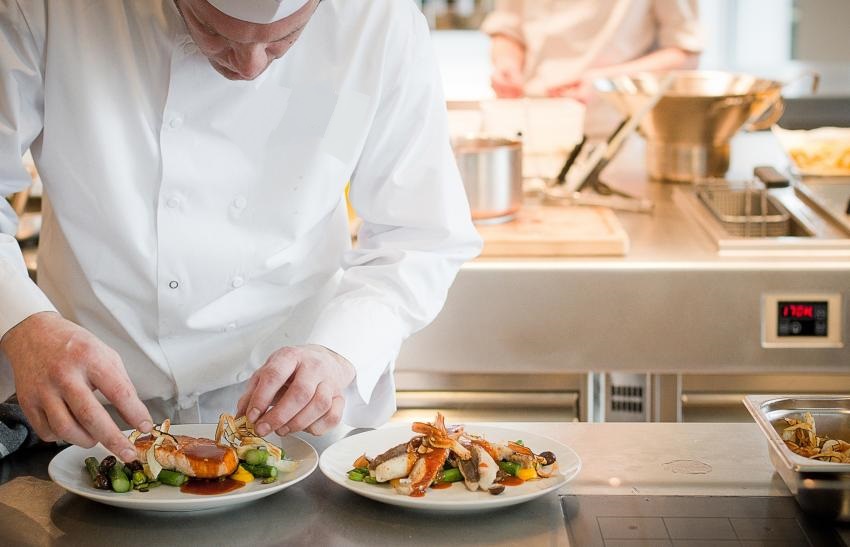From Farm to Fork: Knowing the Importance of Food Origins
In the foodservice industry, maintaining high standards for the food that comes into your back door is important – both from a food quality and a food safety perspective. One often overlooked aspect of achieving these standards is knowing the source of your food. Understanding where your ingredients come from can significantly impact your operation, food safety, customer satisfaction, and overall business success.
Many operators, including myself, ordered most of our items from a national broadline distributor. While mistsakes can happen in any business, these businesses generally do an excellent job of ensuring the food that they source to sell to you comes from reputable and established producers and growers. But, as we enter the summer months and fresh produce is readily available from local purveyors, food safety is an important aspect to keep in mind.
One misconception we often hear in programs such as farm to school or other farm to business programs is the thought that if a product is local, it must be safe. While this may be the case, it is not always true. The National Outbreak Reporting System data showed that from 2009 through 2021, there were over 2,000 outbreaks related to fresh produce, causing over 48,000 illnesses and 65 deaths. Granted, this data doesn’t show the source of the product in terms of a local supplier vs. a broadline distributor. But, when you get the product locally, you need to make sure the grower applies the same safeguards to the growing of that product than those who supply your local broadline distributor would.
While the farmer down the street may have a great product, ask the right questions, and ensure she or he follows the same practices that you might expect in your own kitchen.
A good starting point in discussing safety and quality with any local grower is to ask about what Good Agricultural Practices (GAP) training or certification they have received. While having certification is not a requirement, it can tell you a bit about their background related to these practices.
If possible, visit the farm and observe their practices. Or sit down with the grower and ask about things such as pesticide and chemical use, irrigation, and transport.
Many farmers use pesticides or other chemicals on their crops. If not applied correctly or if the produce is not properly washed before consumption, residues of these chemicals can remain on the fruits and vegetables, posing health risks.
If irrigation is used, ask the grower what the source of the water is and if testing is done on the water. In recent years, produce has been contaminated by pathogens like E. coli or Salmonella from soil, water sources, or handling practices. Improper irrigation, animal waste runoff, or poor hygiene during harvesting and processing can contribute to contamination.
Even if the produce is safe when harvested, mishandling during transport or improper storage conditions can lead to cross-contamination. For example, if fruits and vegetables come into contact with unclean surfaces or are stored at incorrect temperatures, they can become contaminated. How does the grower transport the product from the farm to your place of business? If she or he uses a truck (for example), what else is the truck used for? For example, was a dog or potentially livestock in the back of the truck the day before?
Small-scale local farmers may have limited resources or access to training on food safety practices. Without proper knowledge or infrastructure, they may inadvertently compromise the safety of their produce.
My colleagues at Iowa State University have a great resource available for the purchasing of local produce – and the best part, the price is right – free! Check out their Checklist for Retail Purchasing of Local Fresh Produce for an excellent resource that will help you ensure the safety of local produce as it comes into your operation. While the farmer down the street may have a great product, ask the right questions, and ensure she or he follows the same practices that you might expect in your own kitchen. Risk Nothing.
READ MORE POSTS
Top Food Safety Websites
You ask…How do I learn about food safety regulation? What pathogens in foods can make me sick? What temperature should I safely cook my roast beef to and how do I take food temperatures? How do I clean and sanitize anything according to the FDA Food Code? What and where is the most recent version of the FDA Food Code? Where can I find food safety educational materials galore in book form or online? Do I need them in Spanish or a Chinese dialect?
A Little Poultry Safety Information
Chicken is the number one species of protein consumed by Americans – we eat about 80 pounds of it per year. Outbreaks of foodborne illness have long been associated with poultry and eggs usually by undercooking it or cross-contamination of other foods by raw poultry. Recent concerns about avian or bird flu put the direct focus on our fowl food with concerns about whether this awful disease can transfer from birds to humans.
The Basic Principles of Food Safety
Every food establishment uses, processes, and sells food in different ways. However, the general issues and key principles of food safety remain the same, whatever the style of the operation. All food safety training programs should contain the “big 3” factors that could cause food to become unsafe. Food must be kept out of harms way from human errors, but if you don’t train food workers what they are, they won’t know why these factors are so important to your operation. The basics can make us or break us in one or maybe two food handling mistakes.
Be Aware When You Prepare – Food Prep Tips
The subject of food preparation covers some very broad, basic principles within food safety, with many steps associated with “risk” in some recipes. Certainly, preparation steps are where the most mistakes have occurred if a foodborne illness should occur. Outbreaks usually happen when more than one mistake occurs during prep, but sometimes it only takes one. Cooking is the biggest risk for raw foods, but all foods become ready-to-eat foods at some point in final preparation steps and that’s where the most care is required.









